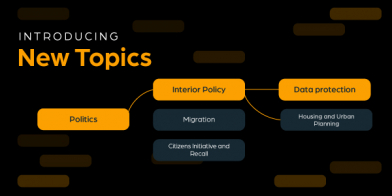How to Turn Historical News Data into Actionable Competitive Intelligence

When it comes to doing business, staying ahead often comes down to making the right decision faster than your competitors. But decisions made without the right context or understanding of what worked in the past and why can quickly put your company at risk of falling behind.
Historical news data provides businesses with something real-time updates cannot: the ability to see how trends evolve and decisions play out over time. It reveals patterns in competitor strategies, customer behaviors, and market shifts that can’t be captured in the moment, enabling companies to benchmark decisions on proven outcomes.
Take Amazon, for example. Reports reveal that the company uses a shell company to gather intelligence on competitors like Walmart and Shopify. They study logistics, pricing strategies, and seller processes to refine their strategy and stay one step ahead. It’s no wonder Amazon remained the top US seller in 2024, with Walmart consistently at its tail.
But how can analyzing the past uncover insights that drive smarter, more strategic decisions going forward?
Why historical news data is important for competitive intelligence
As industries move faster, competition grows more global, and new technologies disrupt established markets, companies using historical data to monitor the competition will generate more revenue than those that do not. Globalization has also expanded the scope of competition, requiring companies to evaluate rivals worldwide while accounting for regional differences in strategy and market needs. This kind of external data for competitive intelligence is what enables organizations to respond quickly to changes, from emerging competitors to shifts in customer behavior driven by technologies like AI and mobile, and consistently disrupt their industries.
Historical news data-driven insights directly impact key areas of competitive intelligence, including:
- Product Launch Strategies – Analyzing past campaigns reveals what messaging resonated with audiences and what fell flat, empowering businesses to identify tactics that drove engagement, avoid repeating ineffective approaches, and design more impactful campaigns informed by proven outcomes.
- Competitor Supply Chain Insights – Tracking how competitors responded to disruptions and adapted their supply chains can help companies build more resilient supply chains that are prepared for challenges, minimize downtime, and optimize resource allocation.
- Trend analysis – Examining performance trends over time allows businesses to benchmark against past results and monitor shifts in market behavior. This helps organizations identify emerging opportunities and refine their strategies to align with long-term changes in customer preferences or industry dynamics.
Challenges in gathering sufficient data
Challenges in gathering sufficient news data for competitive intelligence can prevent businesses from gaining the insights needed to analyze trends, understand competitors, and make strategic decisions:
- Many businesses struggle to access historical archives, which are often incomplete or unavailable. Without these archives, it becomes nearly impossible to analyze how trends evolved or assess the outcomes of past competitor strategies.
- Global markets require insights from diverse languages, but without coverage that includes key regional languages, companies miss out on critical local trends and customer behaviors that could inform their strategies.
- Manual data collection is resource-intensive, especially at scale. Collecting data manually leaves too much room for human error, resulting in possible missed information and already-limited resources having to stretch even thinner.
- Standardizing historical data is a complex process. Data collected from different sources can arrive in formats that are incompatible with each other. It takes a lot of time and resources to make sure all data feeds are standardized.
The solution: historical web data
A well-designed archive of historical data gives businesses access to relevant, structured competitive intelligence that helps them track keywords and trends, analyze competitors, and make informed decisions.
With the right Archived Web Data, organizations can:
- Access the full text of each article, blog, discussion, and review.
- Receive comprehensive historical data in a standard format (JSON).
- Request the exact data you need and receive that data set.
- Access years of historical data to benchmark competitor performance and identify long-term trends.
- Use multilingual coverage to track regional nuances and understand market behaviors in different parts of the world.
- Analyze enriched data with features like categorization, social signals, domain rank, and ratings (when relevant).
- Information from the past 10+ years.
Studying last year’s software launches can uncover which features were more successful than others, informing next year’s product upgrades.
Access to at least five years of data
Trend analysis and competitor benchmarking require a wide lens to identify patterns and evaluate the effectiveness of past strategies. As such, archived web data should provide access to historical news data that spans a minimum of five years, like Webz.io’s archives, which offer web data going back over 10 years. This allows you to track changes over time, assess market developments, and study the evolution of competitor behavior.
Broad language coverage
Effective competitive analysis depends on your understanding of global and local trends, which means sourcing data from multiple regions and languages is a must. The best APIs provide access to news in multiple languages as well as to localized insights and Webz.io’s data archive is no exception, including 80 TB of historical data in 170+ languages. Access historical data from 9M+ daily news articles, ensuring no important trends or data are missed due to language limitations.
Trusted and reputable domains
A strong API also connects you to a wide range of trusted news outlets and domains, delivering reliable data for competitive analysis. And beyond traditional news outlets, access to blogs, forums, and reviews adds a broader context to historical insights. This kind of coverage helps businesses understand how public sentiment and customer feedback have shifted over time.
Up your competitive intelligence with Archived Web Data
Using historical news data helps businesses make smarter, more informed decisions by uncovering patterns and trends that drive success. With the right historical data archive, the possibilities go beyond collecting data, empowering how your business leaders uncover connections, anticipate shifts, and create strategies that put you ahead of the competition. And given the massive flow of data being created every day, the tools you choose today will undoubtedly shape the insights you deliver tomorrow.
Learn more about how Archived Web Data can equip your business with smarter insights from historical news archives.





